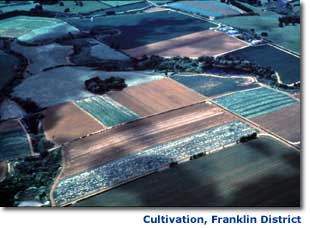Soil Management in the Franklin District
Intensive agriculture is damaging soils in the Franklin District. The Franklin Sustainability Project is trialing techniques to help protect soils and make land use in the area more sustainable.
Franklin soils
 Parts of the Franklin district, such as Pukekohe and Tuakau, are home to some of the Waikato’s most versatile soils. But intensive agriculture, such as commercial vegetable growing, is causing increased erosion and a decline in soil structure and organic matter.
Parts of the Franklin district, such as Pukekohe and Tuakau, are home to some of the Waikato’s most versatile soils. But intensive agriculture, such as commercial vegetable growing, is causing increased erosion and a decline in soil structure and organic matter.
Monitoring of two Pukekohe paddocks shows large amounts of soil are moving downhill. On average, 98 mm or 21 tonnes/ha/year of topsoil has moved since 1952. Less than one percent of this soil is recovered from drains and roads. Any soil recovered is used for landfill rather than returned to paddocks, because of concerns about pests and diseases.
A 2002 study showed soil losses of 7-30 tonnes/ha/year, depending on slope. This represents a loss of $35 to $570 worth of topsoil nutrients. Large areas of field have lost all their original topsoil, and the present topsoil is mainly derived from subsoil, crop residues and heavy additions of fertiliser.
Our soil is a non-renewable resource. We need to reduce soil loss to maintain productivity.
The Franklin Sustainability Project
In 1997, the Franklin Sustainability Project was set up to:
- test a range of sustainable land management techniques
- involve growers in planning and monitoring the techniques.
The Pukekohe Vegetable Growers Association and Agriculture New Zealand lead the project. They are testing:
- surface water runoff management using contour drains, grassed waterways, silt traps, and raised access ways to reduce erosion and nitrate leaching
- the use ofcover crops and mulching to reduce erosion and nitrogen leaching, increase organic matter and improve soil structure
- ripping and vegetating wheel tracks to increase infiltration and reduce run off and erosion
- reducing cultivation to improve soil structure, boost organic matter levels, and reduce erosion
- the impacts of subsoiling - tilling the soil without turning it upside down - on infiltration and erosion
- irrigation management to improve efficiency,reduce run off and nitrate leaching
- fertiliser management, optimising fertiliser rates and timing to reduce nitrate leaching while maintaining production
- integrated pest management to reduce the use of pesticides
- soil quality monitoring so growers can monitor and manage changes in soil quality.
The project emphasises education and voluntary involvement.
Technical advice and funding for the project are offered by:
- Waikato Regional Council
- Auckland Regional Council
- Franklin District Council
- Crop and Food Research
- New Zealand Vegetable and Potato Growers Federation
- Landcare Research
- MAF Policy
- Ministry for the Environment.
Want to find out more?
Check out our information on the causes of erosion in the Waikato region and how to minimise them.
Check out our information on cultivation in the Waikato region, what it does to soil and how to increase soil organic matter.
To find out more about preventing fertiliser runoff read the NZ Fertiliser Manufacturer’s Research Association Code of Practice for Fertiliser Use.


To ask for help or report a problem, contact us
Tell us how we can improve the information on this page. (optional)